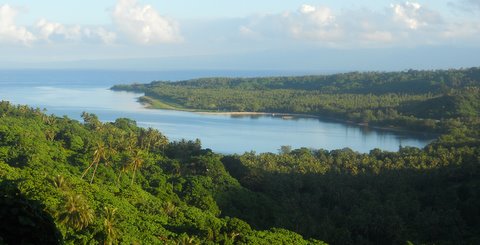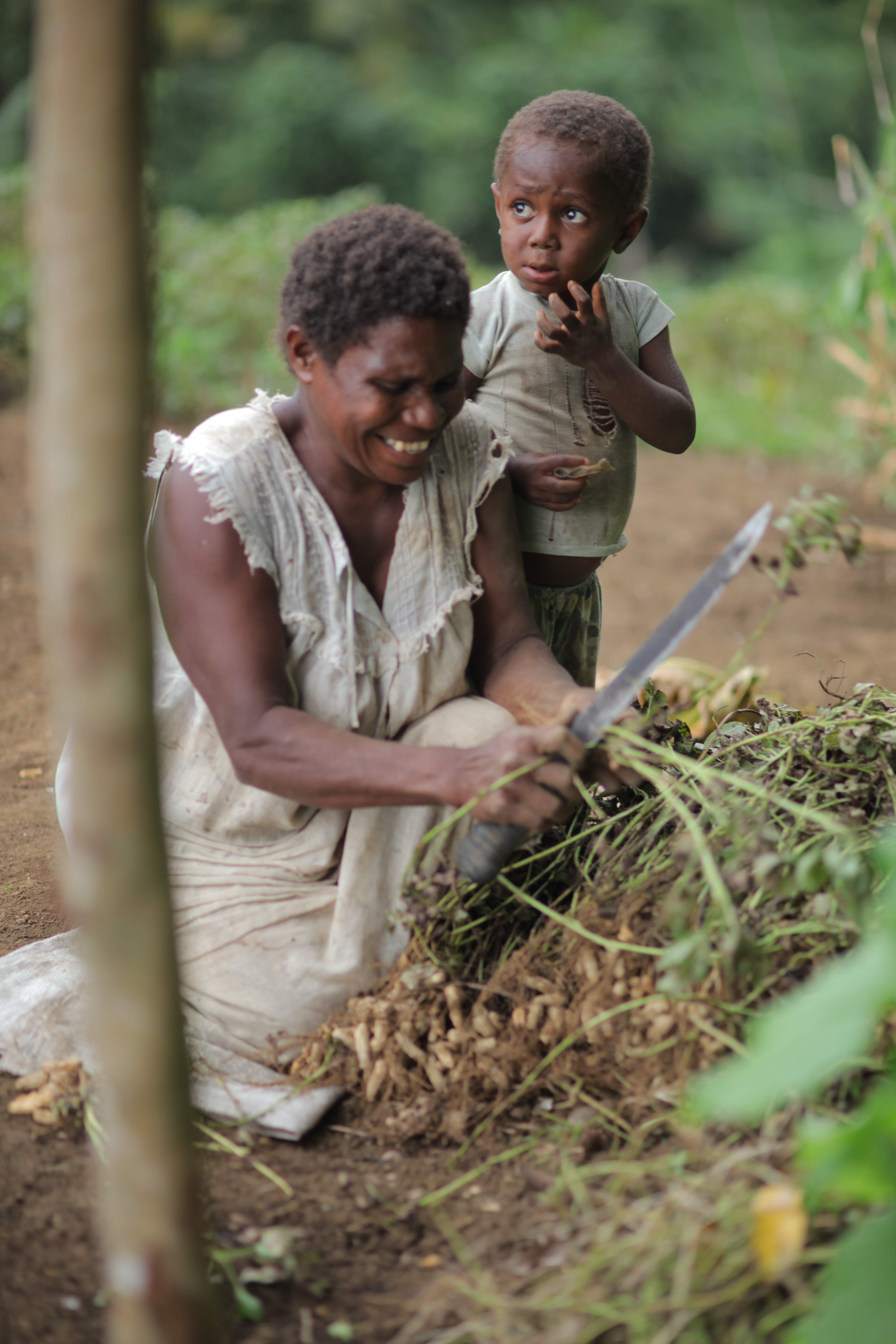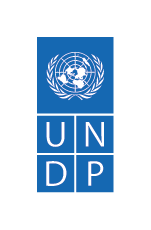Vanuatu National Adaptation Programme of Action (NAPA)
Project Overview
In Vanuatu climate change is likely to impact all sectors especially agriculture, water, coastal and marine resources and infrastructure as well as tourism. The major climate change concerns of Vanuatu presented in the NAPA are projected sea level rise, sea temperature rise and the possible increase in cyclones and other major storm events. Agriculture is entirely rain-fed and is susceptible to changes in rainfall distribution. Intense and prolonged rainfall could damage seedlings, result in greater run-off and soil erosion and encourage conditions that promote pests and diseases. Drought combined with higher temperatures could cause added thermal stress on plants.
Projected increases in sea surface temperatures combined with increased ocean acidification (from increased CO2 concentrations in the atmosphere) are likely to put pressures on the marine food chain (particularly reef systems and other calcifying organisms such as planktons) which in turn potentially threatens aspects of marine food supply and associated livelihoods. The incidence off vector-borne disease such as malaria and dengue fever, and water-borne diseases such as dysentery and diarrhea are likely to increase and shift in distribution (malaria likely to extend further southwards).
Project Details
Vanuatu is an archipelago of approximately 80 volcanic islands, with an area of approximately 12,336 square kilometers located off the north-eastern coast of Australia. The island’s population of approximately 221,000 individuals is predominantly rural and relies mostly on agriculture, tourism, raising cattle and offshore financial services (UKFCO, 2011).
In Vanuatu climate change is likely to impact all sectors especially agriculture, water, coastal and marine resources and infrastructure as well as tourism. Agriculture is entirely rain-fed and is susceptible to changes in rainfall distribution. Intense and prolonged rainfall could damage seedlings, result in greater run-off and soil erosion and encourage conditions that promote pests and diseases. Drought combined with higher temperatures could cause added thermal stress on plants. Projected increases in sea surface temperatures combined with increased ocean acidification (from increased CO2 concentrations in the atmosphere) are likely to put pressures on the marine food chain (particularly reef systems and other calcifying organisms such as planktons) which in turn potentially threatens aspects of marine food supply and associated livelihoods. The incidence off vector-borne disease such as malaria and dengue fever, and water-borne diseases such as dysentery and diarrhea are likely to increase and shift in distribution (malaria likely to extend further southwards).
There is a high level of awareness among key stakeholders in Vanuatu of the risks posed by the hazards associated with climate change and natural disasters. Vanuatu is the only Pacific Island Country to have completed both a National Adaptation Program of Action (NAPA) and a National Action Plan (NAP) for Disaster Risk Reduction. A recent Global Fund for Disaster Risk Reduction (GFDRR) stock taking exercise, building on the NAPA and the NAP, also identified priorities. The stock-take also emphasized the links between climate change adaptation and disaster risk reduction and the relevance of this approach for the Pacific Islands. Furthermore, the government is committed to follow through on the Hyogo Framework to integrate the management of climate change adaptation and disaster risk reduction. Additionally, there is a commitment to merge the National Advisory Committee on Climate Change (NACCC) and the National Disaster Management Committee (NDMC).
Adaptation Needs and Priorities
- Agriculture: The diversification of crops to help increase the resilience of agricultural systems to climatic extremes; and better understanding of horticulture in the face of changes in productivity, pests/pathogens and the growth requirements of subsistence crops.
- Human Health: Furthering the work that has already been done in environmental management to aid in the control of malaria, dengue and filiarisis; researching proper waste disposal to minimize contamination in the face of cyclones/floods; and management of surface water to maintain quality and supply.
- Freshwater Resources: Management of water catchments to minimize pressure on groundwater resources; reducing vulnerability of the water supply in rural and urban areas; water conservation efforts; and expansion of rainwater storage capacity through rainwater harvesting.
- Coastal Developments: Modeling of the storm surge zone with consideration of sea level rise; planning initiatives for infrastructure to be able to withstand cyclones, high floodwater flows and high intensity rainfall; exclusion of extractive activities from the coastal zone; replanting littoral vegetation in cleared and degraded areas; identifying areas that are highly vulnerable and planning for worst case impacts to communities; and technical planning for relocation of communities.
- Coastal Marine Environments: Community based marine resource management programs that consider modern and traditional management strategies and aquaculture; and planning around local economic opportunities that are an alternative to the harvesting of marine resources in the face of rising sea levels, greater concentrations of marine carbon dioxide and rising marine temperatures.
- Forestry: Promoting sustainable forestry management.
- Social and Cultural Concerns: Identification of coping strategies for the impacts of climate change on food security, land resources and water availability; and fostering collaboration between social institutions to identify and prioritize social vulnerabilities.
- Broad Economic Impacts: Expanding the range of agricultural products; selection of plant varieties that are better suited to predict future climates; identifying opportunities to reduce reliance on coastal marine resources; relocating infrastructure to areas of low vulnerability; and introducing sustainable tourism programs.
- National Advisory Committee on Climate Change [NACCC] (2007). National Adaptation Programme for Action. Retrieved from http://unfccc.int/resource/docs/napa/vut01.pdf
- Secretariat of the Pacific Community [SPC] (2011). Adapting Climate Change in Vanuatu. Retrieved from http://www.spc.int/en/component/content/article/216-about-spc-news/745-adapting-to-climate-change-in-vanuatu.html
- United Kingdom Foreign and Commonwealth Office [UKFCO] (2011). Asia and Oceania: Vanuatu. Retrieved from http://www.fco.gov.uk/en/travel-and-living-abroad/travel-advice-by-country/country-profile/asia-oceania/vanuatu?profile=all
- Vanuatu Metorological Services [VMS] (1999). Vanuatu National Communication to the Confrence of the Parites to the United Nations Framework Convention on Climate Change. Retrieved from http://unfccc.int/essential_background/library/items/3599.php?such=j&symbol=VUT/COM/1%20B#beg
Key Results and Outputs
Key Vulnerabilities
- Agriculture/Food Security
- Coastal Zones and Marine Ecosystems
- Water Resources
- Public Health
Potential Adaptation Measures
Agriculture and Food Security
- Switch to different cultivars
- Improve and conserve soils
- Enhance irrigation efficiency and/or expand irrigation
Water Resources
- Increase water supply, e.g. by using groundwater, building reservoirs, improving or stabilizing watershed management, desalination
- Decrease water demands, e.g. by increasing efficiency, reducing water losses, water recycling, changing irrigation practices
- Improve or develop water management
- Alter system operating rules, e.g. pricing policies, legislation
Coastal Zones and Marine Ecosystems
- Develop Integrated Coastal Zone Management
Project Components
- Preparatory Activities
- Consultation and prioritisation
- Drafting of NAPA and public review
- Endorsement and Publication of NAPA
- Establish NAPA Project Team
- National Stakeholder consultations
- Drafting of prioritised proposals
- Public review and dissemination of NAPA
- Government review and endorsement




